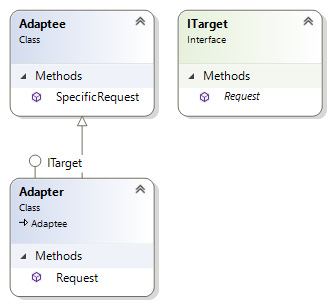Class Adapter Pattern
Description:
Adapter Pattern:» The Adapter pattern joins together types that were not designed to work with each other;
» The Adapter pattern enables a system to use classes whose interfaces don't quite match its requirements.
Class Adapter Pattern:
» Simple and versatile, invisible to the client;
» A class adapter implements an interface and inherits a class;
» Overriding behaviour can be done more easily with a Class adapter.
Use When:
» Create a reusable class to cooperate with yet-to-be-built classes;» Change the names of methods as called and as implemented;
» Support different sets of methods for different purposes.
//Define the Adapter Class, Adaptee Class and Target Interface.
//Define the ITarget interface which defines the class structure that the client will use.
public interface ITarget
{
string Request(int i);
}
//The Adaptee class (object) represents the class, in which the behaviour will be modified by the Adapter class (object).
public class Adaptee
{
public double SpecificRequest(double a, double b)
{
return a / b;
}
}
//The Adapter class (object) inherits behaviour from both the ITarget interface and the Adaptee class.
public class Adapter : Adaptee, ITarget
{
public string Request(int i)
{
return "Rough estimate is " + (int)Math.Round(SpecificRequest(i, 3));
}
}
//Define the ITarget interface which defines the class structure that the client will use.
public interface ITarget
{
string Request(int i);
}
//The Adaptee class (object) represents the class, in which the behaviour will be modified by the Adapter class (object).
public class Adaptee
{
public double SpecificRequest(double a, double b)
{
return a / b;
}
}
//The Adapter class (object) inherits behaviour from both the ITarget interface and the Adaptee class.
public class Adapter : Adaptee, ITarget
{
public string Request(int i)
{
return "Rough estimate is " + (int)Math.Round(SpecificRequest(i, 3));
}
}

//Define the Adapter Class, Adaptee Class and Target Interface.
//Define the ITarget interface which defines the class structure that the client will use.
public interface ITarget
{
string Request(int i);
}
//The Adaptee class (object) represents the class, in which the behaviour will be modified by the Adapter class (object).
public class Adaptee
{
public double SpecificRequest(double a, double b)
{
return a / b;
}
}
//The Adapter class (object) inherits behaviour from both the ITarget interface and the Adaptee class.
public class Adapter : Adaptee, ITarget
{
public string Request(int i)
{
return "Rough estimate is " + (int)Math.Round(SpecificRequest(i, 3));
}
}
//Define the ITarget interface which defines the class structure that the client will use.
public interface ITarget
{
string Request(int i);
}
//The Adaptee class (object) represents the class, in which the behaviour will be modified by the Adapter class (object).
public class Adaptee
{
public double SpecificRequest(double a, double b)
{
return a / b;
}
}
//The Adapter class (object) inherits behaviour from both the ITarget interface and the Adaptee class.
public class Adapter : Adaptee, ITarget
{
public string Request(int i)
{
return "Rough estimate is " + (int)Math.Round(SpecificRequest(i, 3));
}
}